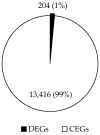Hepatic Lipid Accumulation and Dysregulation Associate with Enhanced Reactive Oxygen Species and Pro-Inflammatory Cytokine in Low-Birth-Weight Goats
- PMID: 35327163
- PMCID: PMC8944635
- DOI: 10.3390/ani12060766
Hepatic Lipid Accumulation and Dysregulation Associate with Enhanced Reactive Oxygen Species and Pro-Inflammatory Cytokine in Low-Birth-Weight Goats
Abstract
Occurrence of low birth weight (LBW) is a major concern in livestock production, resulting in poor postnatal growth, lowered efficiency of feed utilization, and impaired metabolic health in adult life. In the southwest region of China, birth weight of indigenous strains of goats varies seasonally with lower weights in summer and winter, but the metabolic regulation of the LBW offspring is still unknown. In this study, by comparing LBW goats to normal birth weight group, we examined hepatic lipid content in association with regulatory mechanisms. Histological studies showed higher microvesicular morphology in the liver of LBW goats in accompany with a significantly higher level of hepatic free fatty acids, total triglycerides, and cholesterols. Lipid metabolism impairment, increased oxidative stress, and inflammation were observed by transcriptome analysis. Meanwhile, Kyoto Encyclopedia of Genes and Genomes (KEGG) annotation further demonstrated lipid peroxidation, antioxidant pathway, and pro-inflammatory response involved in the hepatic lipid dysregulation from LBW group. Therefore, dysregulations of hepatic lipid metabolism, including fatty acid biosynthesis and degradation, lipid transportation, and oxidative stress, played important roles to contribute the lipid accumulation in LBW goats. Moreover, due to impaired antioxidant capacity, the oxidative damage could interact with persisting pro-inflammatory responses, leading to a higher risk of liver injury and metabolic syndromes in their adult life.
Keywords: antioxidant capacity; goat; lipid accumulation; liver; low birth weight.
Conflict of interest statement
The authors declare no conflict of interest.
Figures










Similar articles
-
Insulin resistance and dyslipidemia in low-birth-weight goat kids.Front Vet Sci. 2024 Mar 26;11:1370640. doi: 10.3389/fvets.2024.1370640. eCollection 2024. Front Vet Sci. 2024. PMID: 38596462 Free PMC article.
-
Sex-specific alterations in hepatic cholesterol metabolism in low birth weight adult guinea pigs.Pediatr Res. 2022 Apr;91(5):1078-1089. doi: 10.1038/s41390-021-01491-w. Epub 2021 Jul 6. Pediatr Res. 2022. PMID: 34230622
-
Perturbation of the lipid metabolism and intestinal inflammation in growing pigs with low birth weight is associated with the alterations of gut microbiota.Sci Total Environ. 2020 Jun 1;719:137382. doi: 10.1016/j.scitotenv.2020.137382. Epub 2020 Feb 20. Sci Total Environ. 2020. PMID: 32114228
-
Cooperation of liver cells in health and disease.Adv Anat Embryol Cell Biol. 2001;161:III-XIII, 1-151. doi: 10.1007/978-3-642-56553-3. Adv Anat Embryol Cell Biol. 2001. PMID: 11729749 Review.
-
Peroxisome Proliferator-Activated Receptors (PPAR), fatty acids and microRNAs: Implications in women delivering low birth weight babies.Syst Biol Reprod Med. 2021 Feb;67(1):24-41. doi: 10.1080/19396368.2020.1858994. Syst Biol Reprod Med. 2021. PMID: 33719831 Review.
Cited by
-
Insulin resistance and dyslipidemia in low-birth-weight goat kids.Front Vet Sci. 2024 Mar 26;11:1370640. doi: 10.3389/fvets.2024.1370640. eCollection 2024. Front Vet Sci. 2024. PMID: 38596462 Free PMC article.
-
Daily Eicosapentaenoic Acid Infusion in IUGR Fetal Lambs Reduced Systemic Inflammation, Increased Muscle ADRβ2 Content, and Improved Myoblast Function and Muscle Growth.Metabolites. 2024 Jun 18;14(6):340. doi: 10.3390/metabo14060340. Metabolites. 2024. PMID: 38921474 Free PMC article.
-
CTCF Represses CIB2 to Balance Proliferation and Differentiation of Goat Myogenic Satellite Cells via Integrin α7β1-PI3K/AKT Axis.Cells. 2025 Aug 5;14(15):1199. doi: 10.3390/cells14151199. Cells. 2025. PMID: 40801631 Free PMC article.
-
Dousing the flame: reviewing the mechanisms of inflammatory programming during stress-induced intrauterine growth restriction and the potential for ω-3 polyunsaturated fatty acid intervention.Front Physiol. 2023 Sep 1;14:1250134. doi: 10.3389/fphys.2023.1250134. eCollection 2023. Front Physiol. 2023. PMID: 37727657 Free PMC article. Review.
-
Daily Injection of the β2 Adrenergic Agonist Clenbuterol Improved Muscle Glucose Metabolism, Glucose-Stimulated Insulin Secretion, and Hyperlipidemia in Juvenile Lambs Following Heat-Stress-Induced Intrauterine Growth Restriction.Metabolites. 2024 Mar 7;14(3):156. doi: 10.3390/metabo14030156. Metabolites. 2024. PMID: 38535316 Free PMC article.
References
Grants and funding
- 31602021/National Natural Science Foundation of China
- cstc2020jcyj-zdxmX0015/Key Project of Chongqing Natural Science Foundation
- 2021[12]/Chongqing's Modern Agricultural Industry Technology System Program for Herbivore
- Cqnyncw-kqlhtxm/Collection, Utilization, and Innovation of Germplasm Resources by Research Institutes and En-terprises of Chongqing
LinkOut - more resources
Full Text Sources

